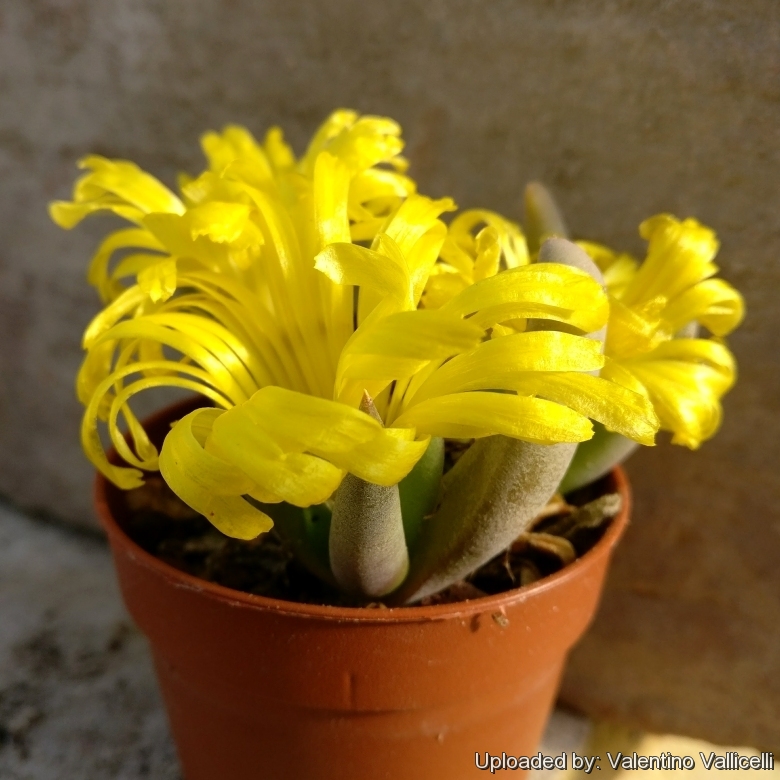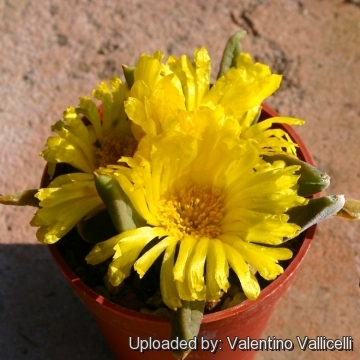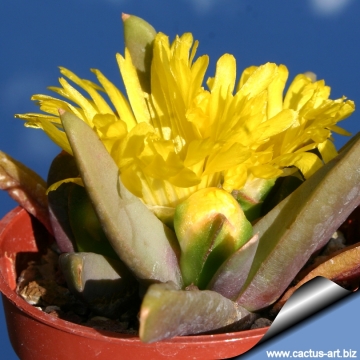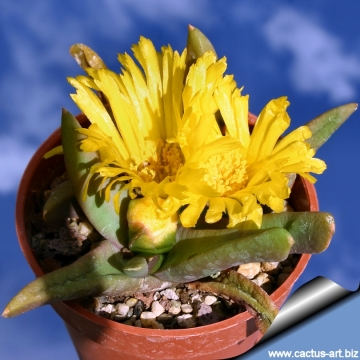Accepted Scientific Name: Glottiphyllum surrectum (Haw.) L. Bolus
Notes Mesembryanthemum [H.M.L. Bolus] 3: 236. 1950 [25 Aug 1950] L. Bolus

Glottiphyllum parvifolium Photo by: Valentino Vallicelli
SB651 Brandrivier, LK The flowers are long-lived, large, golden yellow and very showy.
Origin and Habitat: South Africa ( Ladismith, Laingsburg, Prince Albert, West Cape)
Habitat: Grows on sandstone outcrops often in flat ground under bushes or in open. Rainfall in their native areas is between 100 and 200 mm, especially in March and November. Some plant in habitat have scars or burst in their skins, just like they do at home.
Synonyms:
See all synonyms of Glottiphyllum surrectum
back
Accepted name in llifle Database:Glottiphyllum surrectum (Haw.) L. BolusNotes Mesembryanthemum [H.M.L. Bolus] 3: 236. 1950 [25 Aug 1950]Synonymy: 7
back
Common Names include:
ENGLISH: Tounge-Leaf
Description: Glottiphyllum parvifoliumSN|21462]]SN|21462]] is a nice freely flowering dwarf, compact species (a.k.a. "little leaf glottiphyllum") with small branching stems that form a mat of fleshy leaves. The large, bright yellow flowers look like dandelions. It will slowly forms mats. It is dormant in high summer heat, and dormant in the darkness of a cold winter, but otherwise happy to grow whenever it is watered. Given insufficient light and too much water, they grow into great sprawling masses of fat, bright green leaves. Given a very bright position, the leaves are dark green, almost black at times, with red and purple. There are indeed marked differences in sizes of leaf and flowers in plants from different population and also the growing condition (especially sun exposure and water availability) determine conspicuous differences in habit of cultivate specimens.
Stem: Very short.
Rosettes: With three pairs of leaves arranged cross-wise (placed at right-angles). Individual rosettes about 5-8 cm in diameter.
Leaves: Short thin, not at all tongue-shaped and not dotted, bright dark green with slightly pointed tips, erect (almost terete), in pairs, not widened at the base, slightly decussate, rather round about to 40-60 mm long and about 5-10 mm broad, and nearly as thick. In full sun they may assume a purplish colouring.
Blooming season: Autumn.
Seeds: 1,3-1,4 long x 1,1 mm broad.
Subspecies, varieties, forms and cultivars of plants belonging to the Glottiphyllum surrectum group
 Glottiphyllum parvifolium L. Bolus: has large, bright yellow flowers and grow into great sprawling masses of fat, bright green leaves. Distribution: Ladismith, Laingsburg, Prince Albert, West Cape, RSA.
Glottiphyllum parvifolium L. Bolus: has large, bright yellow flowers and grow into great sprawling masses of fat, bright green leaves. Distribution: Ladismith, Laingsburg, Prince Albert, West Cape, RSA.- Glottiphyllum surrectum (Haw.) L. Bolus
 Glottiphyllum parvifolium SB651 Brandrivier Photo by: Valentino Vallicelli
Glottiphyllum parvifolium SB651 Brandrivier Photo by: Valentino Vallicelli Glottiphyllum parvifolium Photo by: Cactus Art
Glottiphyllum parvifolium Photo by: Cactus Art Glottiphyllum parvifolium Photo by: Cactus Art
Glottiphyllum parvifolium Photo by: Cactus Art Glottiphyllum parvifolium Photo by: Cactus Art
Glottiphyllum parvifolium Photo by: Cactus ArtCultivation and Propagation: The plants in this genus represent some of the more easily cultivated succulent species. Their main growth period is in late winter and were heading for spring-summer dormancy, but they do best with at least a little water all year. Requires little water otherwise their epidermis breaks (resulting in unsightly scars). Water moderately from the middle of summer to the end of winter, and keep the compost almost dry when the plants are dormant. Water minimally in spring and summer, only when the plant starts shrivelling (, but they will generally grow even in summer if given water) In areas prone to frost, grow in an intermediate greenhouse or conservatory, in pots of cactus compost, obtainable from good garden centres. Keep cool and shaded in summer, but provide maximum light the rest of the year. Remember that a sunny locality is best, otherwise they will not flower properly. However there are two ways to grow glottiphyllums: The first is to let nature take her course, which means giving them large pots and copious water; they will burgeon into enormous masses of glistening green leaves. The other is to starve them into svelteness by hot summer droughts, small pots, and firm loam. The results can be very attractive. In any case it is best to treat them as late winter growers. Soft leaves mean easy to damage. May be susceptible to mealybugs.
Propagation: Seeds or cuttings. Seeds germinate very easily and can be sown in early to mid-spring, but can be sown at most times of the year (Avoid very hot weather in summer) and germinated in heated humid environment. Do not sow the seeds too deep. If sown too deep, they will be smothered and probably not germinate. Under ideal conditions, seedlings will grow rapidly. Plant the seedlings out when they are 3–5 cm in height.
Alternatively, use stem cuttings taken towards the end of summer in an heated propagating case (15-21°C) Cuttings root easily and remain true to the species, while seeds tend to hybridize.
Notes: The 50 or so species of this South African genus of succulents are so similar that many may be hybrids.














